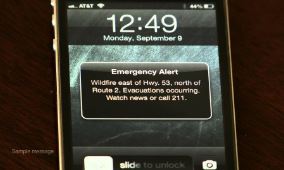
The meeting was billed as a roundtable discussion of lessons learned from January’s false missile alert in Hawaii. Lisa Fowlkes, Chief of the FCC’s Public Safety and Homeland Security Bureau, said information gleaned from the gathering would inform the agency’s open dockets on improving WEA and the Emergency Alert System (EAS).
“We consider WEA to be a bell ringer technology,” said Holly Crawford of the San Diego County, California Office of Emergency Services. She agreed with Nick Crossley of the Hamilton County, Ohio Emergency Management and Homeland Security Agency, that consumers should not be able to opt-out of all WEA messages. “If people can opt-out, lives will be at risk,” said Crawford.
Crossley said to the FCC representatives in the room, that many things can affect the reliability of a cell signal, like fire, lighting strikes or flooding; “I want to hold you to your pledge to get carriers to hold fast to your requirements that WEA enhancements will be made.” One improvement due by May 2019, is expanding the number of characters in a WEA message from 90 to 360, with geo-targeting to follow that November.
During January’s false missile alert in Hawaii, not all cell phone customers received the WEAs. Ryan Hirae, Hawaii Emergency Management Agency, said out of a household of five people, maybe two don’t receive the alert on their device. His organization hopes to work with the carriers, the FCC and FEMA to improve “the success rate.”
In a later panel, John Davis of Sprint said typically, he gets a strong RF signal within seven seconds, however “WEA is not guaranteed delivery,” but rather “It’s a best effort.” To ensure delivery of one WEA message to a customer’s handset, there can be a total of eight text-like messages or “hops” sent between the cell tower and that handset, Davis said, noting the trade-off between speed and delivery. A WEA message can be delivered to the customer base within one minute, for example, he said. He referenced a setting on a tower that’s called an “echo,” in which the alert goes out and the cell tower resends it a few times. “All carriers have that re-broadcast time set differently,” doing what’s best for their network, said Davis.
Robert Morse of Verizon said when a consumer doesn’t receive the WEA, often it’s because that individual has chosen to opt-out or because they’re in a “challenged RF area.” He called WEA “one tool in a bigger toolbox.”
By Leslie Stimson, Inside Towers Washington Bureau Chief
May 16, 2018




Reader Interactions